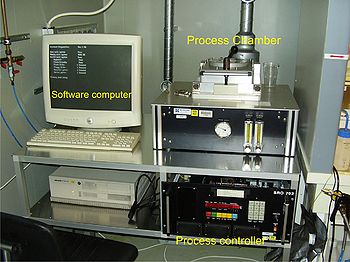Specific Process Knowledge/Thermal Process/BCB Curing Oven: Difference between revisions
Jump to navigation
Jump to search
(Created page with "==This page is under contruction== == BCB Curing Oven == The BCB Curing Oven is mainly used for curing of BCB (bisbenzocyclobutene) and for alloying of metal in a nitrogen a...") |
|||
| Line 27: | Line 27: | ||
|style="background:LightGrey; color:black"| | |style="background:LightGrey; color:black"| | ||
|style="background:WhiteSmoke; color:black"| | |style="background:WhiteSmoke; color:black"| | ||
* | *BCB curing and metal alloying | ||
|- | |- | ||
!style="background:silver; color:black" align="center" valign="center" rowspan="2"|Process parameter range | !style="background:silver; color:black" align="center" valign="center" rowspan="2"|Process parameter range | ||
|style="background:LightGrey; color:black"|Temperature | |style="background:LightGrey; color:black"|Temperature | ||
|style="background:WhiteSmoke; color:black"| | |style="background:WhiteSmoke; color:black"| | ||
*0- | *0 - 450<sup>o</sup>C | ||
|- | |- | ||
|style="background:LightGrey; color:black"|Nitrogen flows | |style="background:LightGrey; color:black"|Nitrogen flows | ||
|style="background:WhiteSmoke; color:black"| | |style="background:WhiteSmoke; color:black"| | ||
* | *Low N<sub>2</sub> flow: 5 SLM | ||
* | *High N<sub>2</sub> flow: Max 16.7 SLM | ||
|- | |- | ||
!style="background:silver; color:black" align="center" valign="center" rowspan="3"|Substrates | !style="background:silver; color:black" align="center" valign="center" rowspan="3"|Substrates | ||
|style="background:LightGrey; color:black"|Batch size | |style="background:LightGrey; color:black"|Batch size | ||
|style="background:WhiteSmoke; color:black"| | |style="background:WhiteSmoke; color:black"| | ||
*Several small samples (placed on | *Several small samples (placed on a carrier wafer) | ||
*One | *One 50 mm wafer (placed on a carrier wafers) | ||
*One | *One 100 mm wafer | ||
|- | |- | ||
| style="background:LightGrey; color:black"|Allowed materials | | style="background:LightGrey; color:black"|Allowed materials | ||
|style="background:WhiteSmoke; color:black"| | |style="background:WhiteSmoke; color:black"| | ||
*BCB | |||
*Co-polymer | |||
*Silicon | *Silicon | ||
*Silicon oxide | *Silicon oxide | ||
*Silicon nitride | *Silicon nitride | ||
*Quartz | *Quartz | ||
* | *Resist (prebaked) | ||
* | *III-V materials | ||
*Metal | |||
|- | |- | ||
|} | |} | ||
Revision as of 10:47, 3 December 2012
This page is under contruction
BCB Curing Oven
The BCB Curing Oven is mainly used for curing of BCB (bisbenzocyclobutene) and for alloying of metal in a nitrogen atmosphere.
During processing the furnace is rapidly heated by use of five halogen lamps below the sample. The furnace is purged with a controlable nitrogen flow. There is vacuum on the furnace.
The user manual, user APV, technical information and contact information can be found in LabManager:
Process information
There are no standard processes on the furnace.
| Equipment | Resist Pyrolysis Furnace | |
|---|---|---|
| Purpose |
| |
| Process parameter range | Temperature |
|
| Nitrogen flows |
| |
| Substrates | Batch size |
|
| Allowed materials |
| |
